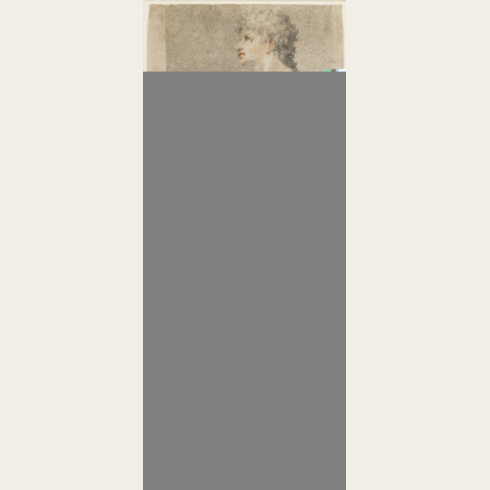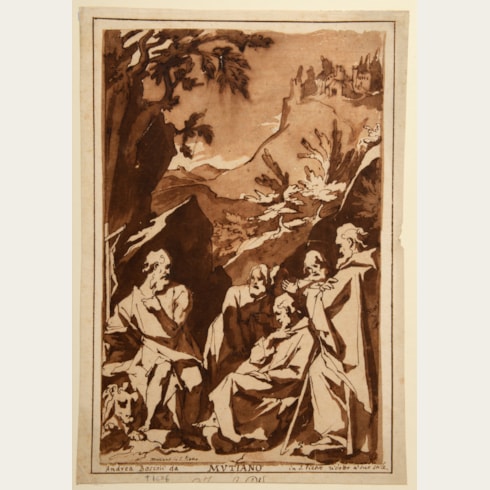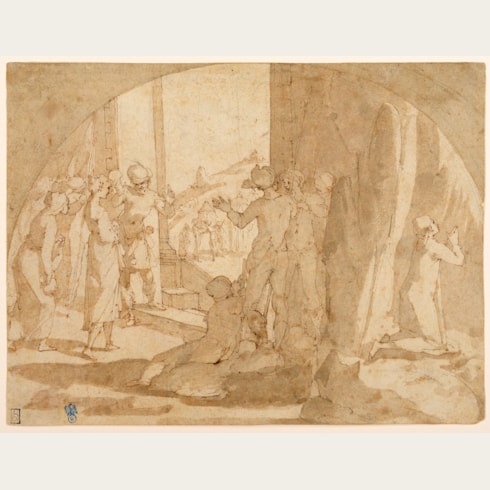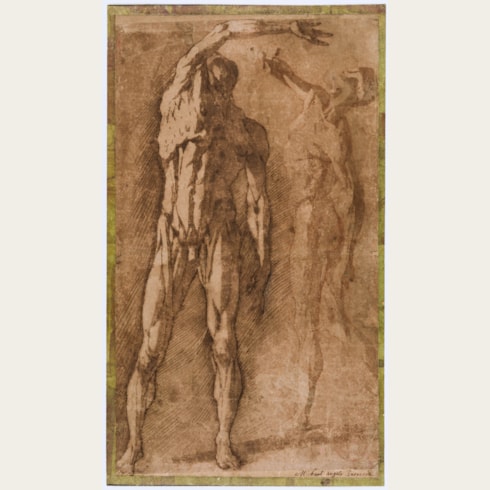Andrea BOSCOLI
(Florence 1560 - Florence 1608)
A Flayed Male Nude, seen from Behind, after Pietro Francavilla
376 x 214 mm. (14 3/4 x 8 3/8 in.)
For each of these drawings, Boscoli has copied, from several different angles, a bronze statuette of a flayed man by the Franco-Flemish sculptor Pietro Francavilla (1548-1615), a pupil and assistant of Giambologna in Florence. The only extant cast of this écorché sculpture is today in the Jagiellonian University Museum in Cracow in Poland, where it has been recorded since the late 18th century. As Anthea Brook has noted of Francavilla’s bronze, ‘in this statuette the mannerist delight in the intricacies of contrapposto is taken to unusual lengths. The static poses of earlier anatomical illustrations of the 15th and 16th centuries were developed by the time of Vesalius’s Treatise (1543) into a more mannerist style, in which the bend of the heads and the gestures if the hands are expressive and pathetic. It would be indeed be difficult to find a more instructive example of mannerist sculpture than the present statuette.’ The Florentine biographer Filippo Baldinucci wrote of Francavilla that he produced a number of écorché statuettes in terracotta that were cast several times and were avidly studied by artists.
Nadia Bastogi has noted in particular ‘the heroic dynamism of these anatomical studies’ by Boscoli, and has dated these drawings, with their painterly use of white heightening on blue paper, to the final years of the 16th century.
Andrea Boscoli trained in the Florentine studio of Santi di Tito and was admitted into the Accademia del Disegno in 1584. He visited Rome as a young man in the early 1580’s and, like many artists before him, avidly copied the frescoes of Polidoro da Caravaggio that decorated the facades of several palaces there. Between 1582 and 1600 Boscoli worked primarily in Florence, with brief stays in Siena and Pisa. His earliest known painting is the Martyrdom of Saint Bartholomew, painted in 1587 for the cloister of the Florentine church of San Pier Maggiore. He was also involved in the decorations for the apparati celebrating the marriage of the Grand Duke Ferdinando I de’ Medici to Christina of Lorraine in 1589.
In 1592 Boscoli completed a fresco cycle for the Villa di Corliano at San Giuliano Terme, near Pisa, and the following year painted an altarpiece of The Annunciation for the Chiesa del Carmine in Pisa. In 1597 Boscoli painted a Visitation for the Florentine church of Sant’ Ambrogio, followed two years later by a Crucifixion for SS. Apostoli, now lost, and an altarpiece of The Preaching of Saint John the Baptist in the church of San Giovanni Battista in Rimini, signed and dated 1599. Between 1600 and 1605 Boscoli worked mainly in the Marches, painting frescoes and altarpieces for patrons and churches in Fano, Fabriano, Macerata, Fermo and elsewhere, while the last years of his career were spent between Florence and Rome.
Relatively few paintings by Boscoli survive today, and it is as a draughtsman that he is best known. His drawings were highly praised by his biographer Filippo Baldinucci (who noted that ‘he drew so well...without lacking a boldness and an extraordinarily skillful touch’) and were avidly collected. Some six hundred drawings by Boscoli are known, with significant groups of drawings in the Uffizi in Florence (many of which were once part of the extensive collection formed by Cardinal Leopoldo de’ Medici), the Istituto Nazionale per la Grafica in Rome and the Louvre.
Provenance
Exhibition










